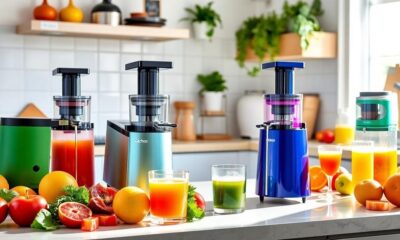Juice Tips and Tricks
How To Make Carrot Juice Without A Juicer

I have always loved making my own juices at home, but I do not have a juicer. Luckily, it is easy and uncomplicated to make carrot juice without a juicer.
Not only is it a fun activity to do at home, but it also provides a variety of health benefits that will leave you feeling energized and refreshed. Carrots are packed with vitamins, minerals, and antioxidants that make them a great addition to any diet. Drinking carrot juice regularly can improve digestion, boost immunity, and even improve your skin’s appearance. Plus, it’s a delicious and refreshing way to get your daily dose of vegetables.
In this article, I’ll walk you through the steps of making carrot juice without a juicer, including how to prepare the carrots, equipment needed, and tips for making the best juice possible. So, grab your cutting board and let’s get started!
Key Takeaways
- Fresh and organic carrots do not require peeling, but conventionally grown carrots should be peeled to remove pesticide residue.
- Carrots need to be chopped into small pieces to make them easier to blend.
- Two main methods for making carrot juice without a juicer are blending and straining with a cheesecloth.
- Other fruits, vegetables, spices, and herbs can be added for flavor and nutritional value.
Benefits of Drinking Carrot Juice
Drinking carrot juice is a great way to give your body a boost of vitamins and nutrients, and it’s super easy to make without a juicer! While there are various juicing techniques out there, using a blender or food processor to make carrot juice is a simple and efficient way to get all the nutritional value of this delicious vegetable.
Carrots are packed with vitamins A, C, and K, as well as potassium and fiber. Drinking carrot juice can help improve your vision, boost your immune system, and even protect against certain types of cancer. It’s also a great way to get your daily servings of fruits and vegetables in a single glass.
Now that you know the benefits of drinking carrot juice, let’s move on to preparing the carrots for juicing.
Preparing Carrots for Juicing
First, you’ll need to grab a bunch of fresh carrots and give them a good scrub under cold running water, feeling the dirt and grime wash away with each stroke. There’s no need to peel the carrots if they’re fresh and organic, as most of the nutrients are located in the skin. However, if you’re using conventionally grown carrots, it’s best to peel them to remove any pesticide residue that might be present. In this case, use a vegetable peeler to remove the thin outer layer of the carrot.
Next, it’s time to prepare the carrots for juicing. Depending on the size of your juicer, you may need to cut the carrots into smaller pieces. You can do this by cutting the carrots into thin slices or chunks. Alternatively, you can use a food processor to grate the carrots into small pieces. This will make it easier for the blender to puree the carrots into a smooth juice.
With the carrots ready to go, it’s time to move on to the next step of blending or straining the juice.
Blending vs. Straining
When it comes to making carrot juice without a juicer, there are two main methods: blending and straining.
Personally, I’ve tried both methods and found that each has its pros and cons. Using a blender is quick and easy, but you’ll need to strain the juice afterwards to remove any pulp.
On the other hand, straining with a cheesecloth takes a bit more time and effort, but it produces a smoother juice without the need for additional straining.
Using a Blender
Using a blender is a quick and easy way to whip up a delicious and healthy glass of carrot juice in minutes! Here are three blender techniques to make the perfect carrot juice:
-
Start by washing and peeling the carrots, then chop them into small pieces to make it easier for the blender to process.
-
Add a small amount of water or juice to the blender to help break down the carrots and create a smoother consistency.
-
Blend the carrots on high for 1-2 minutes until they’re fully pureed. You can add more water or juice to adjust the thickness of the juice to your liking.
There are many recipe variations you can experiment with, such as adding ginger, lemon, or apple to the mix.
Once you’ve blended the carrots, you can strain the juice through a cheesecloth to remove any pulp and achieve a smoother texture.
Now, let’s move on to the next subtopic about straining with a cheesecloth.
Straining with a Cheesecloth
You won’t believe how easy it is to achieve a perfectly smooth texture in your carrot juice by straining it through a cheesecloth. This technique is perfect for those who don’t have a juicer at home.
Simply blend the carrots with water until it becomes a smooth puree. Pour the puree into a cheesecloth and gently squeeze out the juice. You’ll be left with delicious and smooth carrot juice that is perfect for any time of day.
If you don’t have a cheesecloth, don’t worry! There are plenty of alternatives that you can use to strain your juice. You can use a fine mesh strainer or even a clean cotton t-shirt. The key is to find something that will allow the juice to pass through while keeping any pulp behind.
With these straining techniques, you’ll have a perfectly smooth glass of carrot juice in no time. Now let’s move on to the equipment needed to make your own carrot juice at home.
Equipment Needed
All you need is a blender and a fine mesh strainer to make delicious carrot juice at home. While juicers can be expensive and take up a lot of counter space, using a blender is a budget-friendly option that still produces great results.
To make carrot juice without a juicer, simply wash and peel the carrots, chop them into smaller pieces, and blend them with water until smooth. Once blended, use a fine mesh strainer to separate the juice from the pulp. This may take a little bit of effort, but the result will be a smooth and refreshing carrot juice that is packed with vitamins and minerals.
Alternative methods, such as using a cheesecloth or nut milk bag, can also be used to strain the juice if you don’t have a fine mesh strainer. With your freshly made carrot juice, you can now add other ingredients such as ginger or lemon to enhance the flavor and add even more nutrients to your juice.
Adding Flavor and Nutrients
When I make carrot juice without a juicer, I like to mix it with other fruits and vegetables to add different flavors and nutrients. For example, I often add an apple, a beet, and a piece of ginger to my carrot juice to make it sweeter and spicier.
Additionally, I like to experiment with different spices and herbs to enhance the taste and health benefits of my juice. Overall, mixing with other fruits and vegetables and adding spices or herbs can be a fun and creative way to make your carrot juice more delicious and nutritious.
Mixing with Other Fruits and Vegetables
Adding some apples and ginger to your homemade carrot juice can give it a delicious and refreshing twist. Not only do these fruits and vegetables complement the sweetness of the carrots, but they also offer additional health benefits. Apples contribute additional fiber and antioxidants, while ginger adds a spicy kick and is known for its anti-inflammatory properties. If you’re wondering how to store ginger juice, it’s best to keep it in an airtight container in the fridge, where it can last for up to a week. You can also freeze it in ice cube trays for longer shelf life and use it in small portions as needed.
Here are some nutrient pairings and flavor combinations to try:
- Apples: Rich in fiber and vitamin C, they add natural sweetness to the juice.
- Ginger: Known for its anti-inflammatory properties, it adds a spicy kick to the juice.
- Lemon: Helps to balance the sweetness and adds a tangy flavor.
- Spinach: High in iron and vitamin K, it adds a mild green flavor to the juice.
- Pineapple: Contains enzymes that aid in digestion and adds a tropical sweetness to the juice.
By mixing different fruits and vegetables, you can create a unique flavor profile and get a wider range of nutrients. However, it’s important to keep in mind that some combinations may not taste as good as others, so it’s a good idea to experiment and find what works best for you.
To take your juice to the next level, try adding spices or herbs.
Adding Spices or Herbs
Spicing up your homemade carrot juice with herbs or spices is a great way to add more flavor and depth to your drink. There are many spices that pair well with carrot juice, such as ginger, cinnamon, turmeric, and cayenne pepper. Ginger, for instance, is known for its anti-inflammatory properties, while cinnamon can help regulate blood sugar levels.
Turmeric, on the other hand, is a potent antioxidant that can protect cells from damage, while cayenne pepper can help boost metabolism and aid in digestion. When adding spices or herbs to your carrot juice, start with a small amount and gradually increase to taste. You can use fresh or dried herbs, but fresh herbs tend to yield a stronger flavor.
You can either mix the spices or herbs directly into the juice or blend them with the carrots before juicing. Experiment with different spice combinations to find your favorite flavor. Adding spices or herbs to your homemade carrot juice not only elevates its taste but also provides additional health benefits.
Now that your carrot juice is spiced up to your liking, it’s time to talk about how to store it properly.
Storing Carrot Juice
To keep your delicious carrot juice fresh for longer, simply transfer it into an airtight container and store it in the fridge! This is an important step in ensuring that your juice stays safe for consumption and maintains its quality over time.
Here are some tips for long-term storage and freezing your carrot juice:
-
Store your carrot juice in glass containers, as plastic can absorb the flavor and smell of the juice.
-
Label your container with the date you made the juice, so you can keep track of how long it has been in the fridge.
-
If you plan to freeze your carrot juice, leave about an inch of space at the top of the container to allow for expansion during freezing.
Proper storage is key to enjoying your homemade carrot juice for as long as possible.
Now that we’ve covered this topic, let’s move on to some tips for making the best carrot juice.
Tips for Making the Best Carrot Juice
When it comes to making the best carrot juice, there are a few things that I’ve learned through trial and error.
Firstly, choosing the best carrots is essential. Look for fresh, firm carrots that are bright orange in color.
Secondly, adjusting the consistency of the juice can make a big difference in the taste and texture. Adding a little water or ice can help to thin out the juice, while blending longer can create a smoother texture.
Choosing the Best Carrots
Picking out the cream of the crop when it comes to carrots is like finding a needle in a haystack, but it’s worth it for the sweet and crisp taste in your homemade juice.
When choosing carrots for juicing, it’s important to look for fresh, firm, and vibrant ones. Carrot varieties like Nantes and Chantenay are perfect for juicing because of their natural sweetness and juice content. Additionally, organic options are always a great choice as they’re grown without the use of harmful pesticides and chemicals.
When selecting carrots, it’s important to avoid those that are wilted, soft, or discolored. These signs indicate that the carrots are not at their peak freshness and may not produce the best juice.
It’s also important to wash the carrots thoroughly before juicing to remove any dirt or debris.
With the right carrots, your homemade carrot juice will be bursting with flavor and nutrients. And now that you’ve chosen the perfect carrots for your juice, let’s talk about adjusting the consistency for a perfect blend.
Adjusting the Consistency
Achieving the desired texture of your homemade carrot juice is essential to creating a satisfying drink. One way to adjust the consistency is by adding ice cubes to your blender. This not only helps to cool down the juice but also adds a bit of water to dilute the puree. You can start by adding a few ice cubes and then gradually add more until the desired consistency is achieved.
Another way to adjust the consistency is by adjusting sweetness. You can add honey, agave syrup, or any other sweetener of your choice to balance out the flavors. It’s best to add sweeteners gradually, tasting the juice as you go along to ensure that you don’t overdo it. Additionally, blending other ingredients like lemon juice or a splash of fresh fruit juice can help in improving the taste of aloe vera juice. A pinch of salt or a dash of cinnamon may also enhance the overall flavor profile, making it more enjoyable. Remember to experiment with different combinations until you find the perfect balance that suits your palate.
Once you’re happy with the texture and sweetness of your carrot juice, it’s time to move on to cleaning up.
Cleaning Up
Okay, now it’s time to tackle the mess you’ve made, but don’t worry, cleaning up after making carrot juice without a juicer is a breeze with just a few simple steps.
First, it’s important to clean your equipment immediately after use. Rinse all parts with warm water and use a brush to remove any pulp stuck in crevices. To prevent staining, avoid using hot water and abrasive sponges.
Next, consider minimizing waste by finding creative ways to use the leftover carrot pulp. It can be added to smoothies, baked goods, or even used as a natural dye for fabrics. Additionally, the pulp can be composted or used as a fertilizer for plants. By finding alternative uses for the pulp, not only are you reducing waste, but you’re also getting the most out of your ingredients.
With the cleaning tips and creative uses for carrot pulp in mind, let’s dive into some delicious ways to use your homemade carrot juice.
Creative Uses for Carrot Pulp
So, I’ve been experimenting with making carrot juice at home without a juicer. I found that I was left with a lot of carrot pulp. Instead of throwing it away, I started looking into creative ways to use it.
Two ideas that caught my attention were incorporating it into baking recipes and composting it. By using carrot pulp in recipes like muffins or bread, I could add extra nutrition and moisture to the baked goods.
Alternatively, by composting the pulp, I could create nutrient-rich soil for gardening.
Baking Recipes
If you’re in the mood for something sweet, try whipping up a batch of carrot cake with your freshly made carrot juice. Carrot pulp can actually be used in a variety of baking recipes, including muffins, breads, and even cookies.
If you’re not in the mood for cake, try making some carrot muffins by combining the pulp with flour, sugar, and eggs. You can also experiment with flavor variations by adding in spices like cinnamon or nutmeg, or even some chopped nuts or raisins.
Baking with carrot pulp not only adds a nutritious element to your desserts, but it also reduces waste by making use of the leftover pulp from your carrot juice. And if you’re really trying to minimize waste, consider composting the remaining pulp after you’ve baked with it.
By composting, you can turn your leftover food scraps into nutrient-rich soil for your garden or plants. So go ahead and indulge in some sweet treats, knowing that you’re also doing your part to reduce food waste.
Composting
Don’t be a waste monster! Composting your leftover food scraps is a simple way to reduce your environmental impact and create nutrient-rich soil for your plants.
Composting techniques vary depending on your lifestyle and available resources. If you live in an urban area, you can try vermicomposting by using worms to break down your food scraps. This can be done indoors or outdoors, and the resulting worm castings are a great soil amendment.
If you have a backyard or access to outdoor space, you can try traditional composting. This involves layering your food scraps with other organic materials like leaves, grass clippings, and wood chips. As the materials decompose, they create heat that helps to break down the waste. The end result is a nutrient-rich soil amendment that you can use in your garden to grow healthy plants.
Composting is a great way to reduce waste, save money on fertilizer, and create a healthier environment for your plants. Give it a try and see how easy it can be to turn your food scraps into soil enrichment!
Frequently Asked Questions
Can I use baby carrots instead of regular carrots for juicing?
Yes, baby carrots can be used for juicing and have the same nutritional value as regular carrots. They are also convenient and require less prep work. However, they may not yield as much juice as larger carrots.
What are some common mistakes to avoid when making carrot juice without a juicer?
When making carrot juice without a juicer, common mistakes include not properly washing the carrots, using too many or too few carrots, and not blending long enough. Best practices include using fresh, organic carrots and blending until smooth.
How much carrot juice should I drink per day for maximum health benefits?
For maximum health benefits, incorporate carrot juice into your daily routine. Start with a small amount and gradually increase to 8-16 ounces per day. Alternatives include eating raw carrots and other colorful fruits and vegetables. Carrot juice benefits include improved digestion and vision.
Can I add other fruits or vegetables to my carrot juice for added nutrients?
Yes, adding leafy greens like spinach or kale to carrot juice can increase nutrient intake. Drinking carrot juice in the morning on an empty stomach can optimize absorption.
Is it safe to drink carrot juice if I have a medical condition or take medication?
Coincidentally, I have a medical condition and take medication, but I still drink carrot juice. However, it’s important to check for carrot juice and medication interactions. Drinking carrot juice can have health benefits for those with certain medical conditions.
Conclusion
In conclusion, making carrot juice without a juicer is easy and healthy. It’s a great way to incorporate more nutrients into your diet and it tastes delicious.
By preparing your carrots properly and choosing the right equipment, you can make a nutritious juice in no time. Don’t forget to be creative with your carrot juice by adding different flavors and nutrients, such as ginger or turmeric.
Also, remember to store your juice properly to maintain its freshness. With these tips and tricks, you’ll be making the best carrot juice in no time. So go ahead and give it a try, your body will thank you for it.
Cindy thoroughly researches juicing trends, techniques, and recipes to provide readers with practical advice and inspiration. Her writing style is accessible, engaging, and designed to make complex concepts easy to understand. Cindy’s dedication to promoting the advantages of juicing shines through her work, empowering readers to make positive changes in their lives through the simple act of juicing.
Juice Tips and Tricks
How to Make Aloe Vera Juice Taste Better

Tired of the strong flavor of aloe vera juice? No problem, we’ve got the answer for you.
In this article, we’ll share some tips and tricks to make your aloe vera juice taste better. We have tried and tested various methods to enhance the flavor without compromising the health benefits.
From choosing the right juice to adding natural sweeteners and infusing with fruits and herbs, we’ve got all the information you need to transform your aloe vera juice into a delightful and refreshing beverage.
Let’s dive in!
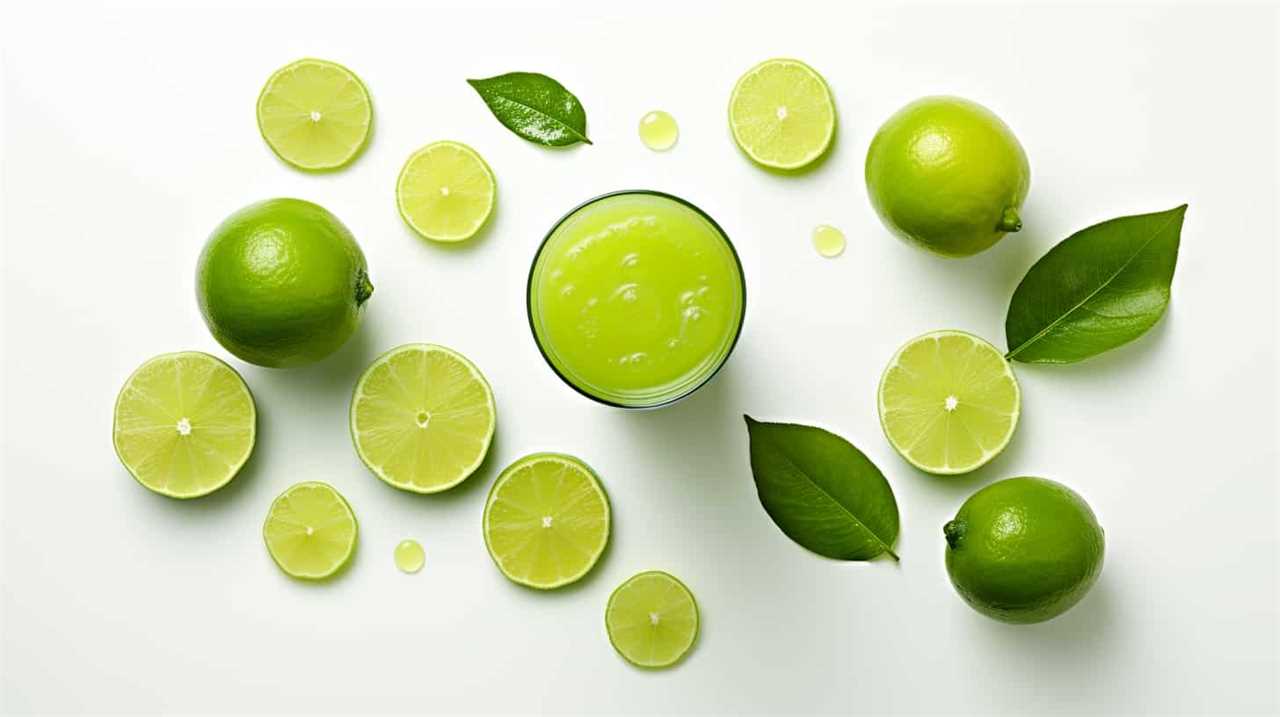
Key Takeaways
- Choose a reputable brand of aloe vera juice that prioritizes quality and uses organic, pure aloe vera.
- Avoid brands that contain added sugars or artificial ingredients.
- Use natural sweeteners like honey, agave syrup, or stevia to enhance the taste of aloe vera juice.
- Experiment with adding fruits, herbs, and other juices to create unique flavor combinations and enhance the health benefits of aloe vera juice.
Choosing the Right Aloe Vera Juice
We can enhance our experience with aloe vera juice by selecting the right brand and type for our preferences. When it comes to finding a reputable brand, it’s important to do some research and read reviews from other consumers. Look for brands that prioritize quality and use organic, pure aloe vera without any added sugars or artificial ingredients. Understanding the health benefits of aloe vera juice is also crucial in making the right choice. Aloe vera is known for its soothing properties, aiding digestion, promoting skin health, and boosting the immune system. By choosing a high-quality brand, we can ensure that we’re getting the maximum benefits from our aloe vera juice.
Now that we know how to choose the right brand, let’s move on to the next step of adding natural sweeteners.
Adding Natural Sweeteners
To enhance the flavor of our aloe vera juice, we can add natural sweeteners such as honey or agave syrup. Using alternative sweeteners not only adds sweetness but also brings unique flavors to the juice. Here are some options to consider:
- Stevia: A natural sweetener derived from the Stevia plant, it’s a zero-calorie alternative to sugar.
- Maple Syrup: This natural sweetener adds a rich and earthy flavor to the aloe vera juice.
- Dates: Pureed dates can be used to sweeten the juice while also providing essential nutrients like fiber.
In addition to using alternative sweeteners, we can enhance the flavor of aloe vera juice by adding spices and extracts. Cinnamon, ginger, or vanilla extract can add warmth and depth to the taste. By experimenting with different combinations of these natural sweeteners, spices, and extracts, we can create a flavor profile that suits our preferences.
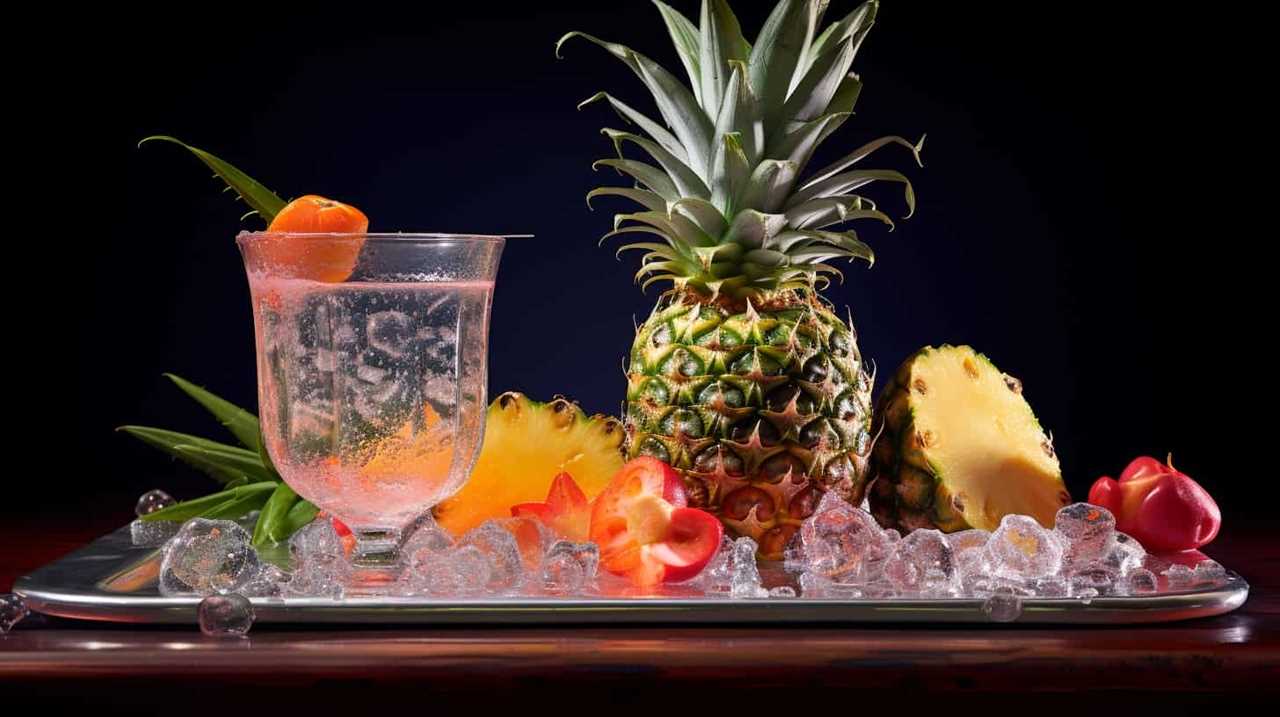
Now, let’s move on to the next section and learn how to infuse aloe vera juice with fruits and herbs to further enhance its taste.
Infusing With Fruits and Herbs
As we explore ways to make our aloe vera juice taste better, one option to consider is infusing it with fruits and herbs. Creating unique aloe vera blends by adding fruits and herbs not only enhances the flavor but also adds a touch of freshness and complexity to the juice. For example, combining aloe vera juice with lemon, mint, or berries can create a refreshing drink that’s both delicious and packed with additional nutrients. It’s similar to the ease of making lemonade with bottled juice—quick, convenient, and customizable to suit your preferences. By experimenting with different fruit and herb combinations, you can elevate your aloe vera juice experience while still reaping its health benefits.
Fruits like strawberries, pineapple, or citrus can add a burst of sweetness, while herbs like mint, basil, or ginger can provide a subtle yet refreshing twist. Exploring the benefits of herbal infusions can also be beneficial for our health. For example, adding a few sprigs of lavender can promote relaxation and reduce stress. Additionally, infusing aloe vera juice with rosemary can aid digestion and boost the immune system.
Blending With Other Juices
Let’s try mixing aloe vera juice with different fruit juices to create delicious and refreshing blends. Blending aloe vera juice with other fruits not only enhances its taste but also adds nutritional benefits to your drink. Here are three fruit juices that you can mix with aloe vera juice:

- Orange juice: Combining aloe vera juice with orange juice not only adds a tangy flavor but also boosts your intake of vitamin C, which is essential for a strong immune system.
- Pineapple juice: Mixing aloe vera juice with pineapple juice creates a tropical blend that isn’t only refreshing but also helps in digestion. Pineapple contains bromelain, an enzyme that aids in breaking down proteins and promoting better digestion.
- Watermelon juice: Blending aloe vera juice with watermelon juice creates a hydrating and refreshing combination. Watermelon is rich in water content and contains electrolytes that can help replenish your body’s fluids.
Experimenting With Flavor Combinations
While we can try various flavor combinations with aloe vera juice, it’s important to find the right balance to enhance its taste. Experimenting with different flavors can’t only make the juice more enjoyable but also enhance its health benefits.
Aloe vera juice is known for its numerous health benefits, such as boosting digestion, promoting hydration, and supporting the immune system. By adding complementary flavors, we can create a refreshing summer drink that not only tastes great but also provides a nutritional boost.
Some popular flavor combinations include mixing aloe vera juice with citrus fruits like lemon or orange, adding a splash of coconut water for a tropical twist, or combining it with cucumber and mint for a refreshing and cooling effect.
Don’t be afraid to get creative and find the flavor combination that suits your taste buds best!
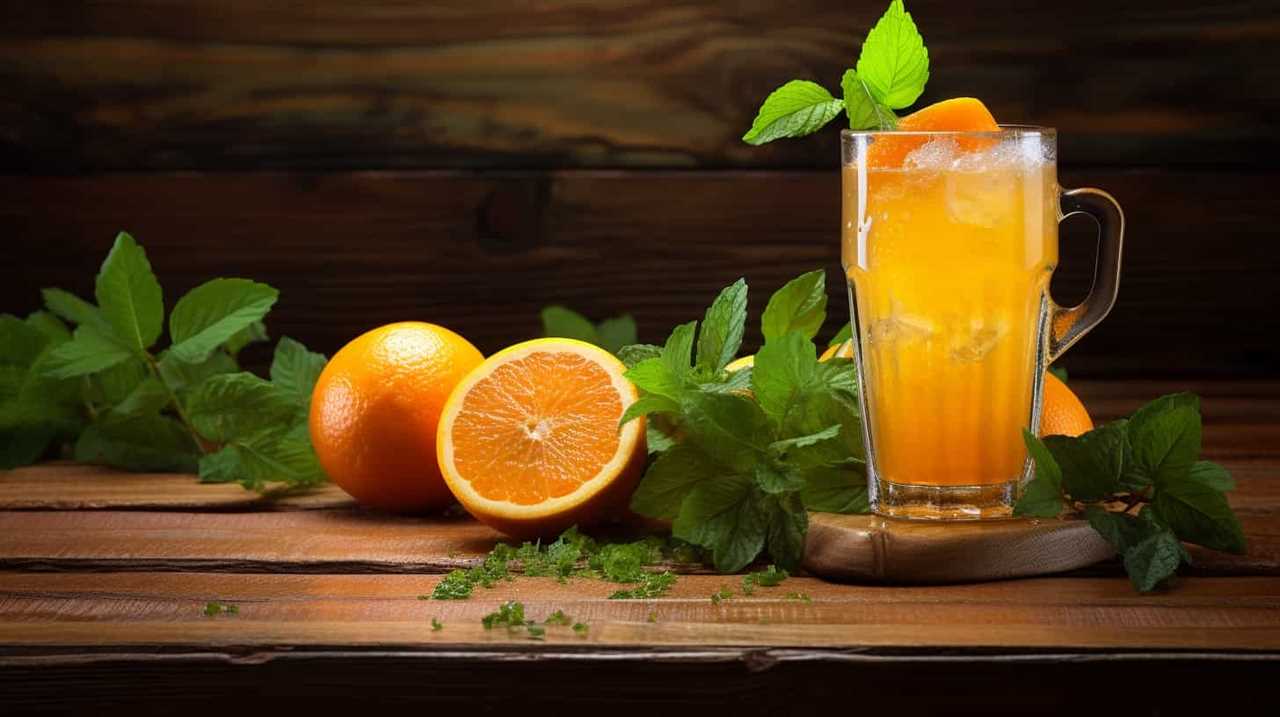
Frequently Asked Questions
Can I Use Store-Bought Aloe Vera Gel Instead of Fresh Aloe Vera for Making Juice?
Yes, you can use store-bought aloe vera gel instead of fresh aloe vera for making juice. However, it’s important to note that fresh aloe vera juice may have more health benefits due to its higher nutrient content.
How Long Can I Store Aloe Vera Juice in the Refrigerator?
Aloe vera juice can be stored in the refrigerator for up to a week. Refrigeration helps maintain the longevity and freshness of the juice, preserving its beneficial properties. It’s important to store the juice in an airtight container to prevent contamination and maintain its quality. Similarly, you might wonder *how long ginger juice lasts*; typically, fresh ginger juice can be refrigerated for about 1–2 weeks as well. Both aloe vera and ginger juices are best consumed within their shelf life to ensure maximum potency and health benefits. Additionally, freezing either juice can extend their shelf life, though some loss of nutrients and potency may occur during the process. When thinking about *how long fresh juice lasts*, it’s crucial to check for signs of spoilage, such as changes in smell, taste, or color, before consuming. To enjoy the best results, it’s always recommended to use fresh ingredients and properly store the juice to ensure you’re getting the most out of its health benefits.
Can Aloe Vera Juice Help With Digestive Issues?
Aloe vera juice can potentially help with digestive issues when taken in appropriate dosages. However, it is important to note that there may be potential side effects. It is always best to consult with a healthcare professional before starting any new supplement regimen.
Can I Use Artificial Sweeteners Instead of Natural Sweeteners in My Aloe Vera Juice?
Using artificial sweeteners in aloe vera juice may affect its taste and potential health benefits. However, natural sweeteners like honey or stevia can enhance the flavor without compromising its nutritional value.

Is It Safe to Drink Aloe Vera Juice Every Day?
Drinking aloe vera juice daily can have numerous benefits, such as improving digestion and boosting the immune system. However, consuming it regularly may also lead to potential side effects like diarrhea or stomach cramps.
Conclusion
In conclusion, making aloe vera juice taste better is easy and enjoyable.
By choosing the right aloe vera juice and adding natural sweeteners, infusing with fruits and herbs, blending with other juices, and experimenting with flavor combinations, you can create a delightful and refreshing drink.
So go ahead and unleash your creativity in the kitchen, and transform your aloe vera juice into a sensational elixir that will transport your taste buds to paradise.
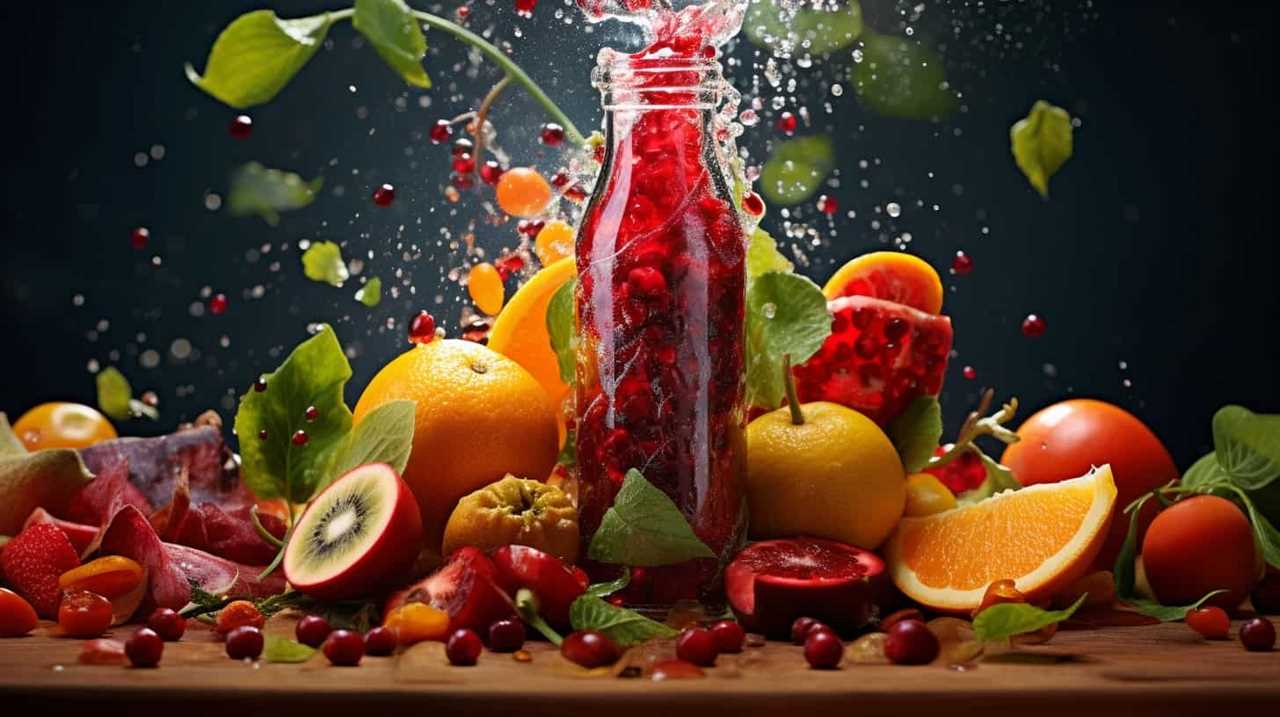
Susannah expertise lies in researching and compiling evidence-based content on juicing, nutrition, and overall health. She is committed to ensuring that The Juicery World offers accurate, up-to-date, and trustworthy information to empower readers to take control of their health. Susannah’s goal is to inspire individuals to embrace juicing as a way to nourish their bodies and live their best lives.
Juice Tips and Tricks
How to Make a Glass of Lemonade With Bottled Lemon Juice

Are you craving a cool glass of lemonade to quench your thirst? Look no further! Try out our perfect recipe using bottled lemon juice that will surely please your taste buds.
In this article, we’ll guide you through the process of creating a tangy and sweet concoction that will leave you feeling refreshed and satisfied.
So grab your ingredients and let’s get started on this delightful journey of serving ourselves and others a glass of pure lemony goodness.
Key Takeaways
- Consider the storage of the bottled lemon juice (dark glass or plastic bottles, protect from light exposure, check expiration date)
- Choose a suitable pitcher and fresh lemons for enhanced flavor
- Store the lemonade concentrate in the refrigerator to maintain freshness
- Adjust the sweetness and tartness to taste with sugar or more lemon juice, and experiment with different sweeteners or additional flavors.
Choosing the Right Bottled Lemon Juice
What are the key factors we should consider when selecting the right bottled lemon juice for our lemonade?

One important factor is how the lemon juice is stored. Look for bottles that are made of dark glass or plastic, as they help protect the juice from light exposure, which can degrade its quality. It’s also important to check the expiration date to ensure freshness.
Another benefit of using bottled lemon juice is convenience. It saves time and effort compared to squeezing fresh lemons. Additionally, bottled lemon juice provides consistent flavor, as the acidity levels are standardized.
When selecting a brand, consider reading reviews and checking for certifications, such as organic or non-GMO.
Gathering the Necessary Ingredients and Tools
How can we gather all the necessary ingredients and tools to make a glass of lemonade with bottled lemon juice? First, we’ll need to collect bottled lemon juice, sugar, and cold water, as well as a pitcher and a spoon for mixing. If you prefer extra flavor, you can also gather ice and optional add-ins like mint or soda water. While preparing the lemonade, it’s easy to understand why some people wonder about other citrus drinks and may ask, “how many oranges per gallon” are needed when making orange juice instead. Once everything is assembled, combine the lemon juice, sugar, and water in the pitcher, stirring until the sugar dissolves. Feel free to adjust the sweetness or tartness to your liking, and don’t forget to add ice or any optional add-ins for an extra refreshing touch. This process might even make you curious about how much juice from oranges is needed when making fresh orange juice compared to using bottled citrus products. Once your lemonade is ready, pour it into a glass and enjoy the refreshing taste. This simple recipe can inspire you to try other homemade juices, such as learning **how to make pear juice** or experimenting with other fruit combinations. Whether you’re using fresh fruits or bottled options, creating your own beverages is a fun and rewarding way to personalize your drinks.
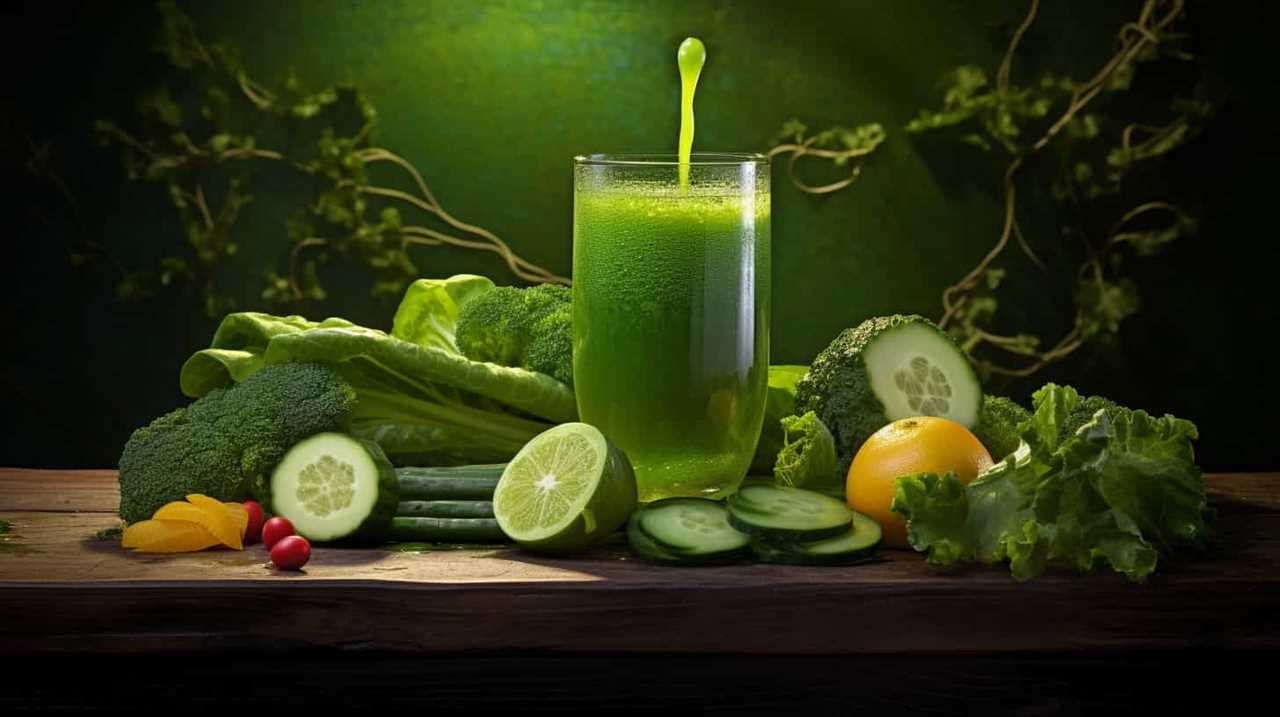
It’s important to start with the right pitcher. Look for a pitcher that’s made of glass or BPA-free plastic, as these materials won’t affect the taste of the lemonade. The pitcher should also have a lid or cover to keep the lemonade fresh and prevent spills.
Now, let’s talk about the lemons. While bottled lemon juice is convenient, using fresh lemons instead can elevate the flavor of your lemonade. Choose lemons that are firm and have a bright yellow color. Give them a gentle squeeze to ensure they’re juicy. To extract the juice, you’ll need a citrus juicer or a reamer. These tools make it easy to get every last drop of juice from the lemons.
Mixing the Lemonade Concentrate
To start mixing the lemonade concentrate, we’ll slowly pour the bottled lemon juice into the pitcher. It’s important to choose the right container for the lemonade concentrate. A pitcher with a lid or a tightly sealed container will help maintain the freshness and prevent any spills or leaks. Once the lemon juice is in the pitcher, we can move on to the next step of adding water and sweetener.
To ensure the lemonade concentrate stays fresh, it’s essential to store it properly. Keep the pitcher in the refrigerator to maintain its cool temperature and prevent any bacteria growth. If you have any leftover concentrate, transfer it to a smaller container with an airtight lid before refrigerating. This will help retain its flavor and prevent any contamination.
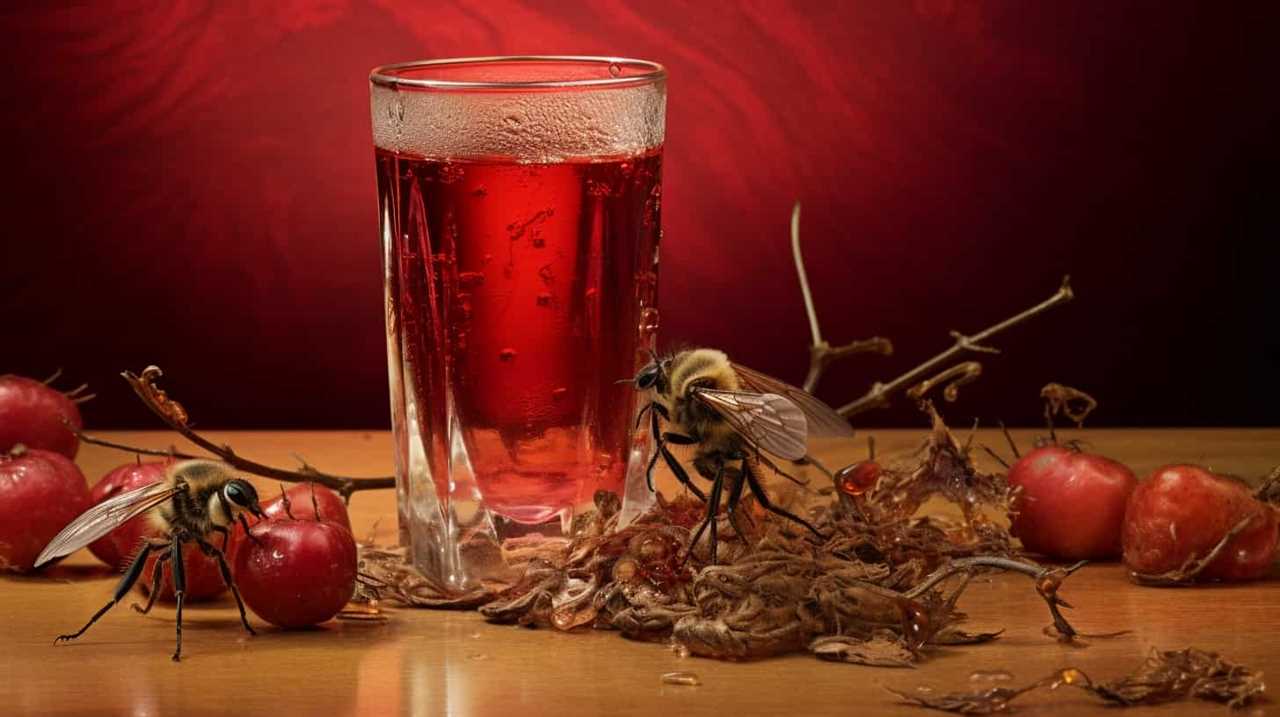
Now that we’ve mixed the lemonade concentrate, it’s time to adjust the sweetness and tartness to taste.
Adjusting the Sweetness and Tartness to Taste
We can adjust the sweetness and tartness of the lemonade to taste by adding more sugar or lemon juice, respectively. If you prefer a sweeter lemonade, simply add more sugar and stir until it dissolves completely. You can experiment with different sweeteners such as honey or agave syrup to find the perfect balance of sweetness.
On the other hand, if you want a tangier lemonade, add more lemon juice gradually, tasting as you go until it reaches your desired level of tartness.
Additionally, you can get creative with your lemonade by adding flavors like fresh mint leaves or a hint of lavender. These additions can elevate the flavor profile and create a more refreshing and unique experience.
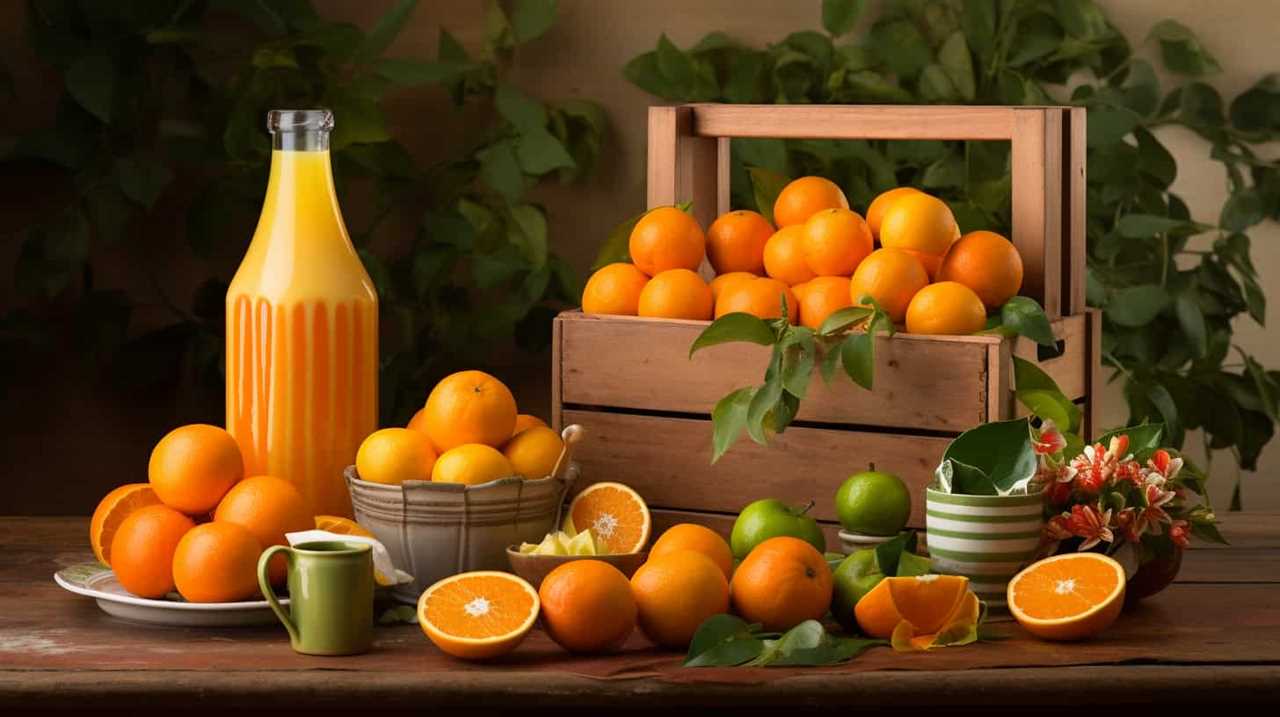
Now that we’ve adjusted the sweetness and tartness of our lemonade, let’s move on to serving and enjoying your refreshing glass of lemonade.
Serving and Enjoying Your Refreshing Glass of Lemonade
Now let’s sit back, relax, and savor our refreshing glass of lemonade.
When it comes to serving and enjoying this delightful drink, there are a few techniques and garnishing options to consider.
Firstly, serving your lemonade chilled is essential for maximum enjoyment. Ensure that you have chilled glasses or add ice cubes to the glasses before pouring the lemonade.

To add a touch of elegance, you can garnish your lemonade with a slice of lemon on the rim of the glass. For an extra burst of flavor, you could also add a sprig of fresh mint or a few berries.
Remember to gently stir the lemonade before serving to evenly distribute the flavors.
Now, take a sip, feel the refreshing tang of lemon, and let the sweet and tart flavors dance on your taste buds.
Cheers!

Frequently Asked Questions
Can I Use Fresh Lemons Instead of Bottled Lemon Juice?
Fresh lemons offer numerous benefits over bottled lemon juice. The taste of fresh lemons is unparalleled, providing a vibrant and tangy flavor. Incorporating fresh lemons into your lemonade will elevate its taste and give it a refreshing and authentic twist.
Can I Substitute Sugar With a Different Sweetener?
Substituting sweeteners in lemonade can enhance the flavor and offer health benefits. We’re knowledgeable about alternative sweeteners and can provide precise, detailed instructions on using them in place of sugar.
How Long Does the Lemonade Concentrate Need to Chill in the Refrigerator?
The chilling time for the lemonade concentrate in the refrigerator is typically around 1-2 hours. Using bottled lemon juice offers the benefit of convenience and consistent flavor for a refreshing glass of lemonade.
Can I Add Other Fruits or Flavors to the Lemonade?
Sure, we can definitely add different fruits or flavors to our lemonade. It’s a great way to experiment with unique flavors and create refreshing, personalized drinks. The possibilities are endless!

How Long Does the Lemonade Stay Fresh in the Refrigerator?
Lemonade made with bottled lemon juice can stay fresh in the refrigerator for about 5-7 days. To maximize shelf life, store it in an airtight container and keep it chilled.
Conclusion
And so, with a few simple steps and the right ingredients, a glass of refreshing lemonade is born.
Like a symphony of flavors dancing on your taste buds, this tangy elixir quenches thirst and brings joy on a hot summer day.
Just a sip transports you to a world of citrusy delight, where the sweetness and tartness blend harmoniously.

So go ahead, indulge in the art of lemonade-making and savor every drop of this sun-kissed nectar.
Cheers to the perfect glass of lemonade!
Susannah expertise lies in researching and compiling evidence-based content on juicing, nutrition, and overall health. She is committed to ensuring that The Juicery World offers accurate, up-to-date, and trustworthy information to empower readers to take control of their health. Susannah’s goal is to inspire individuals to embrace juicing as a way to nourish their bodies and live their best lives.
Juice Tips and Tricks
How to Know if Orange Juice Is Bad

We’ve all been in that situation before – reaching for a glass of orange juice and hesitating, unsure if it’s still okay to drink. Fear not! This article will give you the knowledge you need to determine for sure if your orange juice is still fresh or if it’s gone bad.
With a blend of scientific precision and practical tips, we’ll explore color changes, strange smells, off taste, texture changes, and mold or growth that may indicate spoilage.
Let’s dive in and serve ourselves a refreshing glass of certainty!
Key Takeaways
- Color changes in orange juice can indicate a loss of freshness and shelf life extension, but it doesn’t necessarily mean the juice is bad.
- Unusual or off-putting odors in orange juice, such as sour or fermented scents, can be a sign of poor quality.
- An off taste in orange juice, such as sour, bitter, or fermented flavors, suggests that the juice is spoiled.
- Texture changes in orange juice, such as pulp separation or a thicker consistency, can occur as the juice ages, so it’s important to consume it before the expiration date.
Color Changes in Orange Juice
We should be aware that color changes can indicate whether orange juice is bad.

When it comes to orange juice, color is a crucial factor to consider. As oranges are exposed to air, an oxidation process occurs, which leads to changes in color. Fresh orange juice has a vibrant orange hue, indicating its freshness and high nutritional value.
However, as time passes, the juice may undergo a color change, turning dull or brownish. This change in color is a result of the oxidation process, which affects the flavor and quality of the juice. It’s important to note that while a change in color doesn’t necessarily mean the juice is bad, it does indicate that the juice is losing its freshness and shelf life extension.
Therefore, it’s advisable to consume orange juice when it’s at its freshest, as indicated by its vibrant orange color.
Strange Smells in Orange Juice
When it comes to evaluating orange juice, we should be cautious of any strange smells or odors. A fresh, pleasant smell is indicative of good quality orange juice. However, if you notice any unusual or off-putting odors, it may be a sign that the juice has gone bad. These smells can range from a sour or fermented scent to a rancid or moldy aroma.
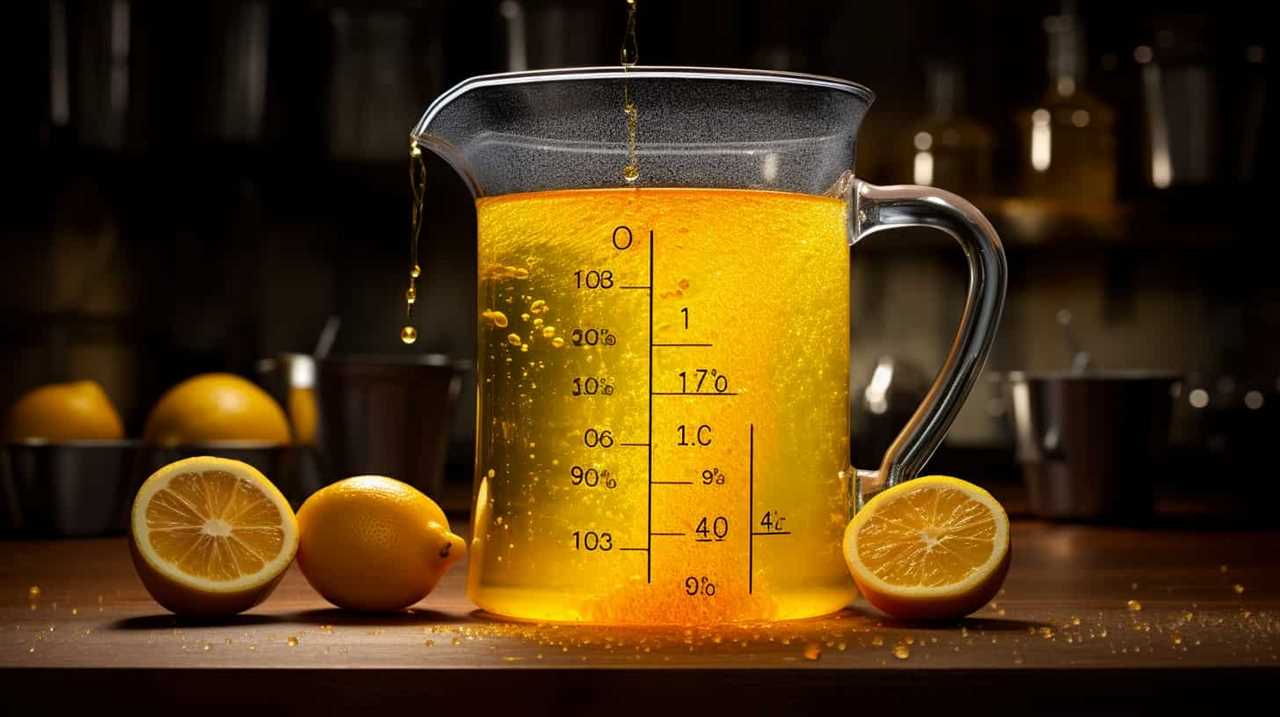
It’s important to note that while some natural variations in scent can occur due to the specific variety of oranges used, any strong or unpleasant smells should raise concerns. If you have citrus fruit allergies, it’s especially important to pay attention to the smell of orange juice, as it could indicate the presence of spoilage or contamination.
Ensuring the quality of orange juice is essential as it’s a popular beverage known for its health benefits, including being rich in vitamin C and antioxidants.
Off Taste of Orange Juice
Our taste buds can detect even the slightest hint of an off taste in orange juice, which can indicate that it has gone bad. The taste of orange juice should be fresh, tangy, and slightly sweet. If it tastes sour, bitter, or fermented, it’s likely spoiled.
One common cause of an off taste in orange juice is the use of overripe oranges. When oranges become overripe, their flavor profile changes, resulting in a less pleasant taste. Another factor to consider is the expiration date. Orange juice that has passed its expiration date is more likely to develop an off taste. It’s important to check the expiration date before consuming orange juice to ensure its freshness and quality. Additionally, improper storage conditions, such as leaving the juice at room temperature for extended periods, can lead to the development of unpleasant flavors. Storing orange juice in the refrigerator helps maintain its freshness for longer. For those exploring different juice options, aloe vera juice flavor tips suggest pairing tart juices with milder flavors to balance the overall taste.
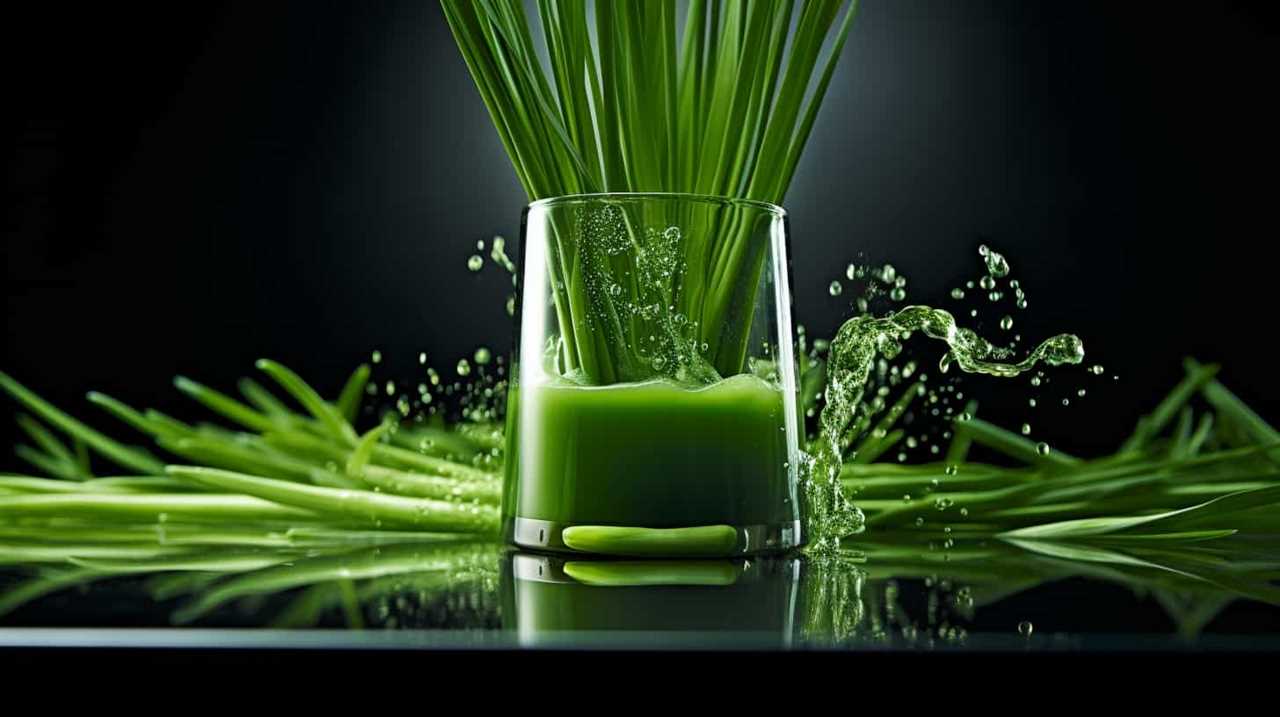
Now, let’s move on to discuss the texture changes in orange juice.
Texture Changes in Orange Juice
As we explore the texture changes in orange juice, it’s important to note that certain factors can cause it to become thicker or develop sediment. One common texture change in orange juice is pulp separation, where the pulp separates from the liquid and settles at the bottom. This can occur naturally over time, as the pulp particles become denser and sink.
Another factor that can affect the texture of orange juice is the expiration date. As orange juice ages, it may start to develop a thicker consistency and even form sediment. This is a result of the natural breakdown of the juice’s components. Therefore, it’s crucial to check the expiration date on orange juice and consume it before it reaches its expiration date to avoid any undesirable texture changes.
Mold or Growth in Orange Juice
We need to be aware of the possibility of mold or other growth occurring in orange juice. Mold can develop in orange juice if it isn’t stored properly or if it has passed its expiration date.

To prevent mold growth, it’s important to follow these steps:
- Store orange juice in the refrigerator at a temperature below 40°F (4°C).
- Check the expiration date on the bottle before consuming. Discard any orange juice that has expired.
- Keep the container tightly sealed to prevent air and moisture from entering, as these can promote mold growth.
Regularly inspecting orange juice for any signs of mold or unusual growth is essential. If you notice any discoloration, a strange odor, or visible mold, it’s best to discard the juice to avoid any potential health risks.
Frequently Asked Questions
Can Orange Juice Go Bad if It’s Stored in the Freezer for Too Long?
Frozen orange juice can potentially lose its nutrients and change its taste if stored in the freezer for too long. It is important to check for signs of spoilage before consuming it.
How Long Can Orange Juice Stay Fresh in the Refrigerator Once It’s Opened?
Once opened, orange juice can stay fresh in the refrigerator for about 7-10 days. To maintain its freshness, store it properly by keeping it tightly sealed and at a consistently cold temperature. If the orange juice develops an off odor, flavor, or appearance, it’s best to discard it to avoid any potential health risks. Factors like exposure to air and varying temperatures can influence how long orange juice lasts, so it’s crucial to handle it with care. Always check the expiration date as a general guide, but remember that proper storage can extend its freshness slightly. Additionally, avoid leaving the orange juice out at room temperature for extended periods, as this can significantly shorten how long orange juice lasts. Freezing the juice can be another option to extend its shelf life, but be aware that this may alter its texture and taste once thawed. By following these precautions, you can ensure your orange juice stays fresh and safe to consume.
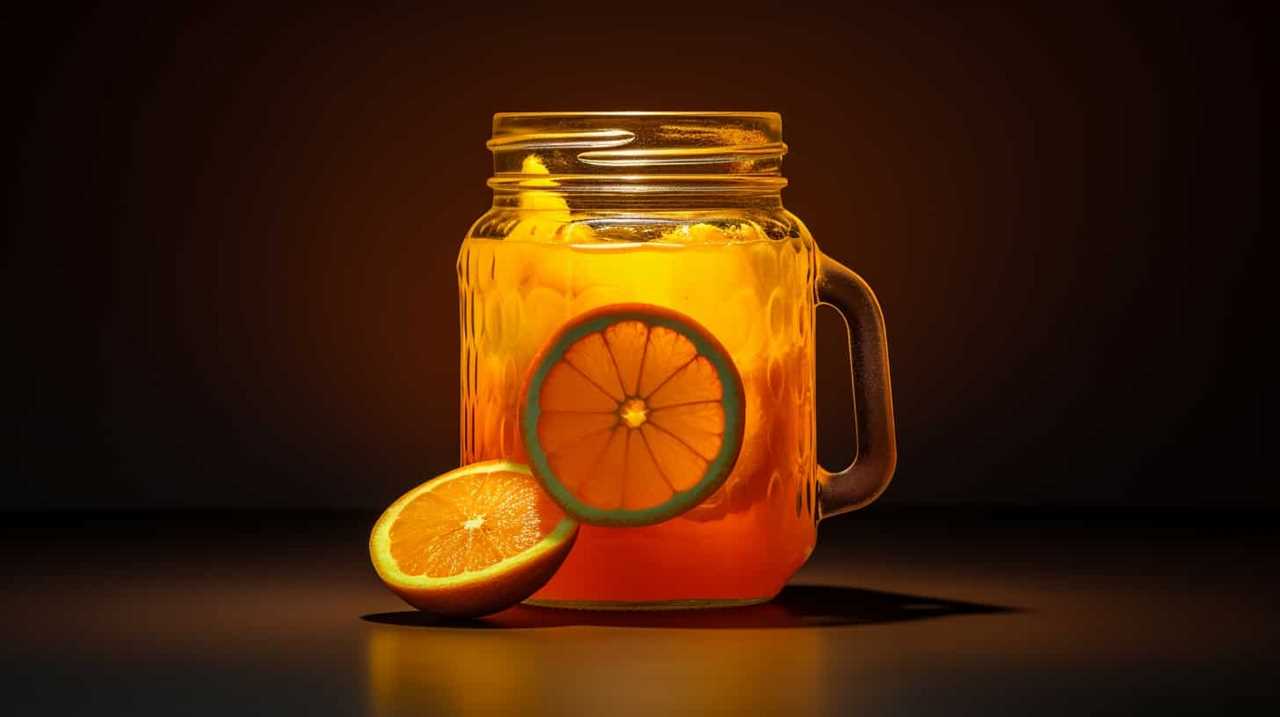
Is It Safe to Consume Orange Juice That Has Been Left Out at Room Temperature Overnight?
Left out orange juice may not be safe to drink as it can harbor harmful bacteria. Signs of spoiled orange juice include a sour smell, mold growth, and a change in color or taste.
Can Orange Juice Develop Harmful Bacteria if It’s Past Its Expiration Date but Still Looks and Smells Fine?
Orange juice can cause food poisoning if it develops harmful bacteria, even if it looks and smells fine. Signs of spoiled orange juice include a sour smell, mold growth, and a change in color or taste.
Does the Nutritional Value of Orange Juice Decrease as It Starts to Go Bad?
As orange juice goes bad, its nutritional value decreases. The longer it sits on the shelf, the more nutrients it loses. Signs of spoilage include a sour smell, off taste, and mold growth.
Conclusion
In conclusion, determining if orange juice is bad requires careful observation of color changes, strange smells, off taste, and texture changes. Just like a detective investigating a case, we must rely on our senses to detect any signs of spoilage.
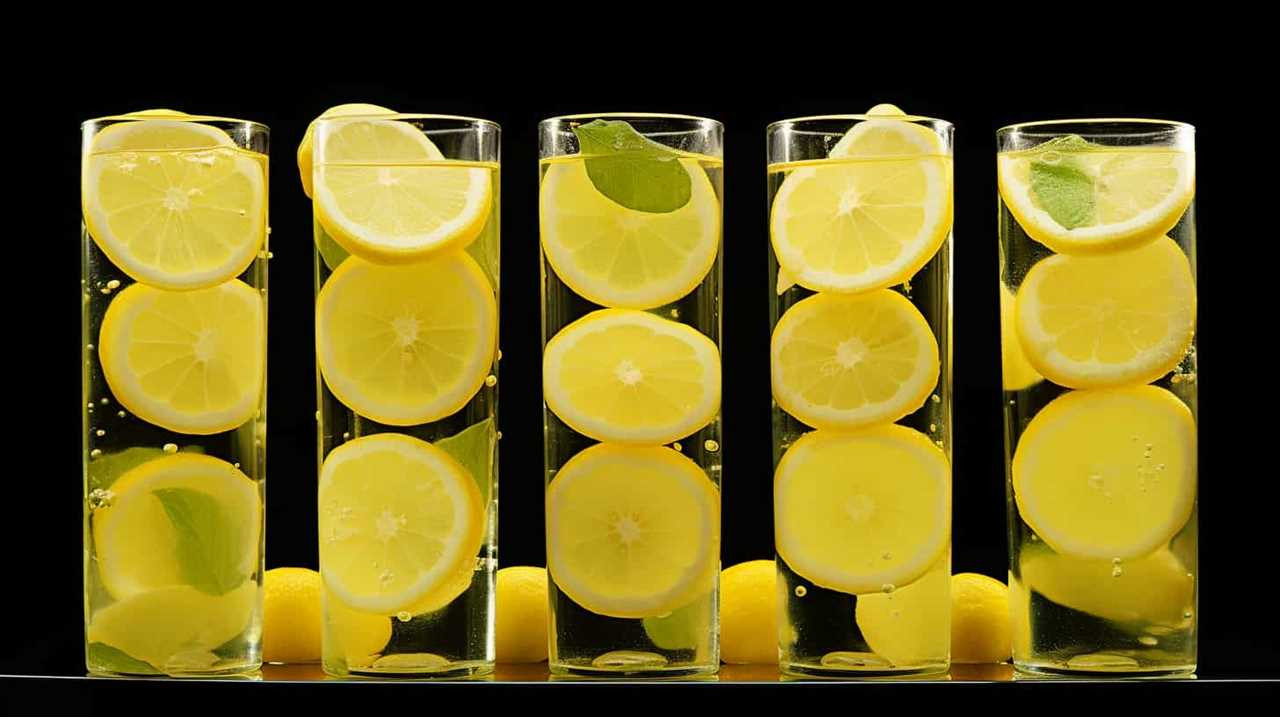
If we detect mold or growth in the orange juice, it’s a clear indication that it’s no longer safe to consume. By remaining vigilant and attuned to these indicators, we can ensure that our orange juice is always fresh and enjoyable.
Susannah expertise lies in researching and compiling evidence-based content on juicing, nutrition, and overall health. She is committed to ensuring that The Juicery World offers accurate, up-to-date, and trustworthy information to empower readers to take control of their health. Susannah’s goal is to inspire individuals to embrace juicing as a way to nourish their bodies and live their best lives.
-

 Vetted2 months ago
Vetted2 months ago15 Best Juices for Diabetics: Refreshing Options That Won’t Spike Your Blood Sugar
-

 Vetted2 months ago
Vetted2 months ago15 Best Decaf Coffee Options for Flavor Lovers Who Need a Caffeine Break
-

 Vetted2 months ago
Vetted2 months ago15 Best Espresso Ground Coffees to Elevate Your Morning Brew
-

 Vetted2 months ago
Vetted2 months ago15 Best K-Cup Coffee Pods for a Perfect Brew Every Time
-

 Vetted2 months ago
Vetted2 months ago15 Best Beans for Espresso: A Guide to Perfecting Your Brew
-

 Vetted2 months ago
Vetted2 months ago15 Best Kona Coffees to Savor the Rich Flavors of Hawaii
-

 Vetted2 months ago
Vetted2 months ago15 Best Inexpensive Espresso Machines That Brew Quality Coffee on a Budget
-

 Vetted2 months ago
Vetted2 months ago15 Best Cold Brew Coffees to Keep You Refreshed All Summer Long
















